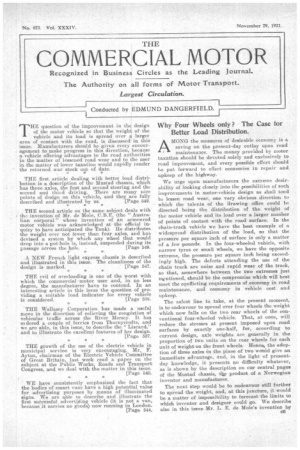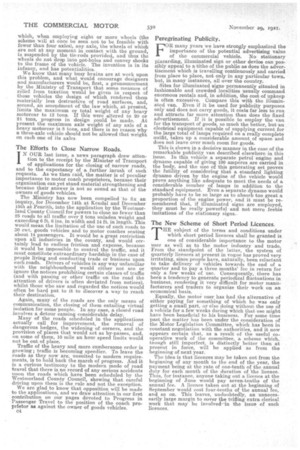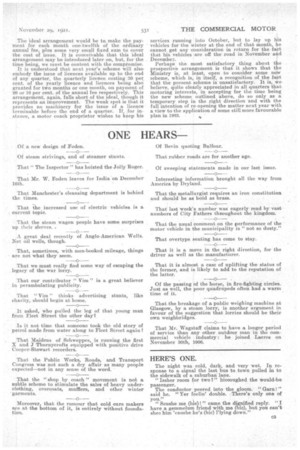Why Four Wheels only ? The Case for Better Load Distribution.
Page 1

Page 2

Page 3

If you've noticed an error in this article please click here to report it so we can fix it.
MONG the measures of desirable economy is a saving on the present-day outlay upon road maintenance. The money provided by motor taxation should be devoted solely and exclusively to road improvement, and every possible effort should be put forward to effect economies in repair and upkeep of the highway.
We urge upon manufacturers the extreme desirability of looking closely into the possibilities of such improvements in motor-vehicle design as shall tend to lessen road wear, one very obvious direction to which the talents of the 'drawing office could he directed being the distribution of the weight of the motor vehicle and, its load over a larger number of points of contact with the road surface. In the chain-track vehicle we have the best example of a widespread distribution of the load, so that the pressure per square inch of surface is only a matter of a few pounds. In the four-wheeled vehicle, with narrow tyres or small wheels, we have the opposite extreme, the pressure per square inch being exceedingly high. The defects attending the use of the chain track are noise and rapid wear of the track, so that, somewhere between the two extremes just mentioned, should be the compromise which will best meet the conflicting requirements of economy in road maintenance, and economy in vehicle cost and upkeep.
The safest line to take, at the present moment, is to endeavour to spread over four wheels the weight which now falls on the two rear wheels of the conventional four-wheeled vehicle. That, at once, will reduce the stresses at present imposed upon road surfaces by exactly one-half, for, according to current design, axle weights are generally in the proportion of two units on the rear wheels for each unit of weight on the front wheels. Hence, the adoption of three axles in the place of two would give an immediate advantage, and, in the light of presentday knowledge, it presents no difficulty whatever, as is shown by the description on our central pages of the Musta,d chassis, the product of a Norwegian inventor and manufacturer.
The next step would be to endeavour still further to spread the weight, and, at this juncture, it would be a matter of impossibility to forecast the limits to which inventor and designer could go. We describe also in this issue Mr. E. de Mole's invention by which, when employing eight or more wheels (the scheme will at once be seen not to be feasible with fewer than four axles), any axle, the wheels of whioh are not at any moment in contact with the ground, is suspended by the tie-rods provided, and thus the wheels do not drop into pot-holes and convey shocks to the frame of the vehicle. The invention is in its infancy, and has potentialities.
We know that many busy brains are at work upon this problem, and what would encourage designers and manufacturers would be, first, a pronouncement by the Ministry of Transport that some measure of relief from taxation would be given in respect of those vehicles the design of which rendered them materially less destructive of road surfaces, and, second, an amendment of the law which, at present, limits the maximum or total weight of any heavy motorcar to 12 tons. If this were altered to 20 or 21 tons, progress in design could be made. At present the maximum axle weight of any axle of a heavy motorcar is 8 tons, and there is no reason why a three-axle vehicle should not be allowed that weight on each one of its axles
The Efforts to Close Narrow Roads.
IN OUR last issue, a news paragraph drew attention to the receipt by the Minister of Transport of applications for the closing of narrow roads, and to the expectancy of a further inrush of such requests. As we then raid, the matter is of peculiar
importance to motor coach proprietors, because their organization can yet stand material strengthening and because their answer is not so sound as that of the owners of goods vehicles.
The Ministry has now been compelled to fix an inquiry, for December 14th at Kendal and December 15th at Penrith, into the application by the Westmor land County Council for powers to close no fewer than 25 roads to all traffic over 2 tons unladen weight and
exceeding 6 ft. 6 ins, in width and 14 ft. in length. This
would mean the limitation of the use of such roads to 30 cwt. goods vehicles and to motor coaches seating about 14 passengers. It would be a great restriction upon all industries in the county, and would certainly lead to endless friction and expense, because it would be impossible to control the traffic, and it must constitute extraordinary hardship in the case of people living and conducting trade or business upon such roads. Drivers of vehicles in any way unfamiliar with the neighbourhood would either not see or ignore the notices prohibiting certain classes of traffic (and with passing or other traffic on the road the attention of drivers is often deviated from notices), whilst those who saw and regarded the notices would often be bard put to it to discover a way to reach their destination.
Again, many of the roads are the only means of communication, the closing of them entailing virtual isolation for some people. In any case, a closed road involves a detour causing considerable delay.
Many of the roads scheduled in the applications actually call for improvement, the removal of dangerous hedges, the widening of corners, and the provision of places that would act as by-passes, and, on some of them, 10 mile an hour speed limits would not be out of place.
Traffic of the heavy and more cumbersome order is growing ; traffic is becoming speedier. To leave the roads as they now are, unsuited to modern requirements, is to hold back the march of progress. And it is a curious testimony to the modern mode of road travel that there is no record of any serious accidents upon the roads which have been scheduled by the Westmorland County Council, showing that careful driving upon them is the rule and not the exception. We are glad to know that opposition will be made to the applications, and we draw attention in our first contribution on our pages devoted to Progress in Passenger Travel to the position of the coach proprietor as against the owner of goods vehicles.
c4
Peregrinating Publicity.
FOR many years we have strongly emphasized the importance of the potential advertising value of the commercial vehicle. No stationary placarding, illuminated sign or other device can possibly appeal to a tithe of the public as does the advertisement which is travelling continuously and carried from place to place, not only in any particular town. but, in many instances, all over the country.
Sites for illuminated signs permanently situated in fashionable and crowded localities usually command enormous rentals and, in addition, the cost of upkeep is often excessive. Compare this with the illuminated van. Even if it be used for publicity purposes only and does not carry goods, it costs far less to run and attracts far more attention than does the fixed advertisement. If it is possible to employ the van for the transport of goods, so much the better, but an electrical equipment capable of supplying current for the large total of lamps required on a really complete outfit, takes up a considerable amount of space and does not leave over much room for goods.
This is shown in a decisive manner in the case of the remarkable publicity van described elsewhere in this issue. In this vehicle a separate petrol engine and dynamo capable of giving 100 amperes are carried in the body. and the size of this generating set proves the futility of considering that a standard lighting dynamo driven by the engine of the vehicle would prove anything like adequate to meet the needs of a considerable number of lamps in addition to the standard equipment. Even a separate dynamo would probably have to be so large as to absorb too great a
proportion of the engine power, and it must be remembered that, if illuminated signs are employed, they must be really powerful and not mere feeble imitations of the stationary signs.
The New Scheme of Short Period Licences.
THE subject of the terms and conditions under which short period licences shall be granted is one of considerable importance to the motor user as well as to the motor industry and trade. From the standpoint of the latter, the system of quarterly licences at present in vogue has proved very irritating, since people have, naturally, been reluctant to take delivery of vehicles towards the end of a quarter and to pay a three months' fee in return for only a few weeks of use. Consequently, there has been a tendency to generate periodical fluctuations in business, rendering it very difficult for motor manufacturers and traders to organize their work on an
economical basis. , Equally, the motor user has had the alternative of either paying for something of which he was only getting a small part, or else doing without the use of a vehicle for a few weeks during which that use might have been beneficial to his business. For some time past the matter has been under the consideration of the Motor Legislation Committee, which has been in constant negotiation with the authorities, and it now appears certain that, as a result of the useful cooperative work of the committee, a scheme which, tnough still imperfect, is distinctly better than at present in force, will be applied as from the beginning of next year. The idea is that licences may be taken out from the beginning of any month to the end of the year, the payment being at the rate of one-tenth of the annual duty for each month of the duration of 'the licence. Thus, for instance, anyone taking out a licence at the beginning of June would pay seven-tenths of the annual fee. A licence taken out at the beginning of September would cost four-tenths of the annual fee, and so on. This leaves, undoubtedly, an unnecessarily large margin to cover the trifling extra clerical work that may be involvedin the issue of such licences. The ideal arrangement would be to make the payment for each month one-twelfth of the ordinary annual fee, plus some very small fixed sum to cover the cost of issue. It is conceivable that this ideal arrangement may be introduced later on, but, for the time being, we must be content with the compromise. It is understood that next year's scheme will also embody the issue of licences available up to the end of any quarter, the quarterly licence costing 30 per cent, of the yearly licence and licences being also granted for two months or one month, on payment of 20 or 10 per cent. of the annual fee respectively. This arrangement, again, fans short of the ideal, though it represents an improvement. The weak spot is that it provides no machinery for the issue of a licence terminable before the end of a quarter. If, for instance, a motor coach proprietor wishes to keep his services running into October, but to Jay up his vehicles for the winter at the end of that month, he cannot get any consideration in return for the fa t that his vehicles are off the road in November ad December.
Perhaps the most satisfactory thing about tlie prospective arrangement is that it shows that tie Ministry is, at least, open to consider some ne scheme, which is, in itself, a recognition of the fart that the present scheme is unsatisfactory. It is, we believe, quite clearly appreciated in all quarters that motoring interests, in accepting for the time being the new scheme outlined above, do so only as a temporary step in the right direction and with the full intention of re-opening the matter next year with a view to the application of some still more favourable plan in 1923.
































